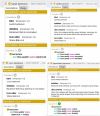A fourfold pathogen reference ontology suite
- PMID: 40635066
- PMCID: PMC12239493
- DOI: 10.1186/s13326-025-00333-6
A fourfold pathogen reference ontology suite
Abstract
Background: Infectious diseases remain a critical global health challenge, and the integration of standardized ontologies plays a vital role in managing related data. The Infectious Disease Ontology (IDO) and its extensions, such as the Coronavirus Infectious Disease Ontology (CIDO), are essential for organizing and disseminating information related to infectious diseases. The COVID-19 pandemic highlighted the need for updating IDO and its virus-specific extensions. There is an additional need to update IDO extensions specific to bacteria, fungus, and parasite infectious diseases.
Methods: The "hub-and-spoke" methodology is adopted to generate pathogen-specific extensions of IDO: Virus Infectious Disease Ontology (VIDO), Bacteria Infectious Disease Ontology (BIDO), Mycosis Infectious Disease Ontology (MIDO), and Parasite Infectious Disease Ontology (PIDO).
Results: IDO is introduced before reporting on the scopes, major classes and relations, applications and extensions of IDO to VIDO, BIDO, MIDO, and PIDO.
Conclusions: The creation of pathogen-specific reference ontologies advances modularization and reusability of infectious disease ontologies within the IDO ecosystem. Future work will focus on further refining these ontologies, creating new extensions, and developing application ontologies based on them, in line with ongoing efforts to standardize biological and biomedical terminologies for improved data sharing, quality, and analysis.
© 2025. The Author(s).
Conflict of interest statement
Declarations. Ethics approval and consent to participate: Not applicable. Consent for publication: Not applicable. Competing interests: The authors declare no competing interests.
Figures







Update of
-
A Fourfold Pathogen Reference Ontology Suite.ArXiv [Preprint]. 2025 Apr 24:arXiv:2501.01454v3. ArXiv. 2025. Update in: J Biomed Semantics. 2025 Jul 9;16(1):12. doi: 10.1186/s13326-025-00333-6. PMID: 40313667 Free PMC article. Updated. Preprint.
References
-
- Arp R, Smith B, Spear A. Building ontologies with basic formal ontology. Cambridge, MA: MIT Press; 2015.
-
- Goldfain A, Smith B, Cowell LG. Dispositions and the infectious disease ontology. In: Galton A, Mizoguchi R, editors. Formal Ontology in Information Systems: Proceedings of the 6th International Conference (FOIS 2010). Amsterdam: IOS Press; 2010. p. 400–413.
-
- He Y, Yu H, Huffman A, Lin AY, Natale DA, Beverley J, Zheng L, Perl Y, Wang Z, Liu Y, Ong E, Wang Y, Huang P, Tran L, Du J, Shah Z, Shah E, Desai R, Huang HH, Tian Y, Merrell E, Duncan WD, Arabandi S, Schriml LM, Zheng J, Masci AM, Wang L, Liu H, Smaili FZ, Hoehndorf R, Pendlington ZM, Roncaglia P, Ye X, Xie J, Tang YW, Yang X, Peng S, Zhang L, Chen L, Hur J, Omenn GS, Athey B, Smith B. A comprehensive update on CIDO: the community-based coronavirus infectious disease ontology. J Biomed Semantics. 2022;13(1): 25. 10.1186/s13326-022-00279-z. - PMC - PubMed
Publication types
MeSH terms
Grants and funding
LinkOut - more resources
Full Text Sources
Medical
Research Materials

